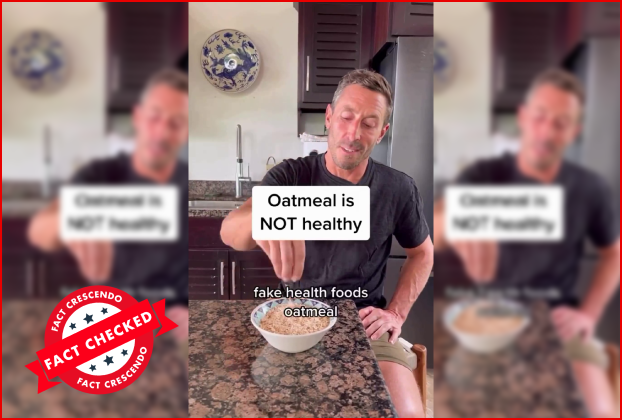Misleading social media claims about nutrition and harmful food components are spreading frequently on various platforms. These claims often include false information about the health benefits or dangers of certain foods, leading to confusion and potentially harmful dietary choices among the public. For instance, there are numerous posts exaggerating the negative effects of common foods and food additives or promoting unverified health benefits of specific diets.
Social Media Posts
Recent claims circulating on social media platforms such as Facebook and Instagram suggest that oats have no nutritional value and that they inhibit the absorption of minerals. This fact-check article aims to address these claims by examining the nutritional profile of oats and the effects of phytic acid, a compound found in oats, on mineral absorption.
Fact Check
Oats (Avena sativa) are a type of cereal grain grown for their seed. They belong to the Poaceae family, which is commonly known as the grass family. This grain is cultivated primarily in temperate regions due to its greater tolerance of rain compared to other cereals.
Source: thejakartapost.com
What is Phytic acid?
Phytic acid (also known as inositol hexakisphosphate or IP6) is a natural substance found in plant seeds. It serves as the principal storage form of phosphorus in many plant tissues, especially bran and seeds. Chemically, phytic acid is a six-fold dihydrogen phosphate ester of inositol (specifically, of the myo isomer), also called the hexaphosphate derivative of inositol. Read more.
Image by Naturalpedia
The following list shows the phytate/phytic acid content per 100 grams in different foods. Read more
Source: Deanna Pecina
Claim 1: Oats Have No Nutritional Value
Oats (Avena sativa) are a species of cereal grain grown for their seed. They are a rich source of several essential nutrients. Uncooked oats are composed of 66% carbohydrates, including 11% dietary fiber and 4% beta-glucans, 7% fat, 17% protein, and 8% water. In a reference serving of 100 grams, oats provide 389 kilocalories and are a significant source of protein (34% of the Daily Value, DV), dietary fiber (44% DV), several B vitamins, and numerous dietary minerals, especially manganese.
The tables below compare the nutritional value per 100 g of uncooked oats.
| Nutritional value per 100 g | |
| Energy | 1,628 kJ (389 kcal) |
| Carbohydrates | 66.3 g |
| Dietary fiber | 11.6 g |
| Fat | 6.9 g |
| Saturated | 1.21 g |
| Monounsaturated | 2.18 g |
| Polyunsaturated | 2.54 g |
| Protein | 16.9 g |
| Vitamins | |
| Thiamine (B1) | 0.763 mg |
| Riboflavin (B2) | 0.139 mg |
| Niacin (B3) | 0.961 mg |
| Pantothenic acid (B5) | 1.349 mg |
| Vitamin B6 | 0.12 mg |
| Folate (B9) | 56 μg |
| Minerals | |
| Calcium | 54 mg |
| Iron | 5 mg |
| Magnesium | 177 mg |
| Manganese | 4.9 mg |
| Phosphorus | 523 mg |
| Potassium | 429 mg |
| Sodium | 2 mg |
| Zinc | 4 mg |
| Other constituents | |
| Water | 8 g |
| β-glucans (soluble fiber) [37] | 4 g |
Data from USDA FoodData Central entry
Thus, the claim that oats have no nutritional value is unfounded. Oats are a nutrient-dense food that provides numerous health benefits.
Claim 2: Oats Reduce Mineral Absorption
The concern about oats reducing mineral absorption primarily revolves around the presence of phytic acid. Phytic acid is the principal storage form of phosphorus in many plant tissues, including bran and seeds. It is known to bind minerals such as calcium, iron, and zinc, forming phytate complexes that are not readily absorbed in the intestines.
Impact of Phytic Acid on Mineral Absorption
Phytic acid is often labeled as an “anti-nutrient” because of its ability to inhibit the absorption of essential minerals. Fred Brouns, a Nutrition and Public Health expert, notes that while phytate can chelate minerals and reduce their bioavailability, this effect needs to be considered in context:
“Phytate (PA) serves as a phosphate storage molecule in cereals and other plant foods. In food and in the human body, PA has a high affinity to chelate Zn2+ and Fe2+, Mg2+, Ca2+, K+, Mn2+, and Cu2+. As a consequence, minerals chelated in PA are not bio-available, which is a concern for public health in conditions of poor food availability and low mineral intakes, ultimately leading to an impaired micronutrient status, growth, development, and increased mortality.”
However, Brouns also highlights the complexity of translating in vitro (laboratory) findings to in vivo (human body) outcomes:
“Frequently observed decreases of PA and increases in soluble minerals in invitro food digestion (increased bio-accessibility) are used to promote food benefits. However, these do not necessarily translate into an increased bioavailability and mineral status in vivo.” The full research paper of Brouns can be found here.
Dental Health: Phytic acid can impact dental health by interfering with the absorption of essential minerals required for the maintenance and repair of teeth. Adequate levels of calcium, phosphorus, copper, and vitamin D are crucial for preventing cavities and gum disease. Without these nutrients, teeth cannot properly re-mineralize, leading to dental issues. Read more here
Dr. Ananda Chandrasekara, chairman of the Sri Lanka Nutrition Association, highlights that while phytic acid content varies between plants, there is no substantial evidence linking oat consumption to malnutrition or nutrient deficiencies if oats are consumed as part of a balanced diet. Further, he simply says, “If you eat only oats for all your food meals, that could be a problem. However, he further explained that oats can aid in managing obesity due to their high resistant starch content.
Learn more about phytic acid’s impact on protein functionality and the bioavailability of micronutrients here and here.
Potential Benefits of Phytic Acid
Despite its potential to inhibit mineral absorption, phytic acid also has several health benefits. It acts as an antioxidant and may offer protection against chronic diseases. According to Overherd oat milk powder company:
“There are two sides to this argument, with countering research suggesting that phytic acid possesses antioxidant properties and may offer benefits for cholesterol management and blood sugar regulation.”
Oats contain beta-glucan, a type of soluble fiber that helps slow digestion, increase satiety, and reduce appetite. Beta-glucan can bind with cholesterol-rich bile acids in the intestine, aiding their excretion from the body. Oats also contain phenolic compounds and phytoestrogens that act as antioxidants, reducing inflammation associated with chronic diseases like cardiovascular disease and diabetes. Read more here and here.
A meta-analysis found that consuming 3 grams of beta-glucan soluble fiber daily from whole oats modestly decreased blood cholesterol levels by about 12 points. Additionally, beta-glucan fiber may help prevent sharp rises in blood sugar and insulin levels after meals, benefiting gut health. Read more here and here.
Therefore, despite its negative impacts on nutrient absorption, phytic acid also offers several health benefits:
- It acts as a powerful antioxidant.
- It may help reduce symptoms of diabetes.
- It can combat heavy metal toxicity.
- It may help reduce the risk of kidney stones.
- It can improve heart health.
- It has potential anti-cancer properties.
- It may aid in the treatment of HIV-1.
Reducing Phytic Acid in Oats
To mitigate the negative effects of phytic acid and improve nutrient absorption, several methods can be employed:
Soaking oats can initiate the germination process, releasing phytase, an enzyme that breaks down phytic acid, thus freeing up the bound minerals. Rinsing grains before soaking is recommended to remove any chemical treatments.
Fermenting oat products can significantly reduce phytic acid content while enhancing the nutritional profile. For instance, yeast-induced fermentation has been shown to improve the protein and dietary fiber content of oats, boost antioxidant activity, and reduce phytic acid levels dramatically. Read more here
Taking a phytase supplement can help break down phytic acid, especially for individuals with nutrient deficiencies or those at risk of such deficiencies.
Advanced biotechnological techniques can be used to biofortify staple crops, potentially reducing phytic acid content and alleviating micronutrient malnutrition in developing countries.
Consuming foods high in phytic acid separately from main meals can minimize its interference with nutrient absorption. Processing techniques for the production of oats can be found here.
Research Insights – How to Reduce Phytic Acid Concentration
- Raj Kishor Gupta et al. from Motilal Nehru National Institute of Technology emphasize the global health issues caused by iron and zinc deficiencies. They suggest that genetic improvements and various pre-treatment methods, such as fermentation and soaking, can reduce phytic acid in foods and enhance their nutritional value. Read more here.
- Ghulam Mustafa et al. from Government College University, Pakistan, found that yeast-induced fermentation of oat bran improves its nutritional and functional aspects, increasing protein, dietary fiber, and antioxidant activity while significantly reducing phytic acid content. Read more here.
- Fatma M. M. Salama conducted trials on oat and barley milk, demonstrating that soaking and heating these grains can reduce phytic acid content. The resulting oat and barley milk contain higher levels of carbohydrates, phosphorus, potassium, iron, and zinc than cow milk, making them suitable alternatives for those allergic to milk protein. Read more here.
Follow us and stay up to date with our latest fact checks.
Facebook | Twitter | Instagram | Google News | TikTok
Conclusion
In conclusion, despite recent social media claims suggesting that oats have no nutritional value and inhibit mineral absorption, these assertions are unfounded. The primary concern about oats revolves around their phytic acid content, which can bind minerals and reduce their bioavailability. However, the impact of phytic acid on mineral absorption should be considered in context, as its effects vary depending on individual dietary patterns and overall nutritional intake. Furthermore, phytic acid also offers several health benefits, including antioxidant properties, potential cholesterol management, blood sugar regulation, and reduced risk of chronic diseases. Ultimately, consuming oats as part of a balanced diet can contribute to overall health and well-being, providing numerous benefits without leading to nutrient deficiencies.

Title:Claims about Oats’ Nutritional Value and Mineral Absorption
Fact Check By: Rashmitha DiwyanjaleeResult: Missing Context






